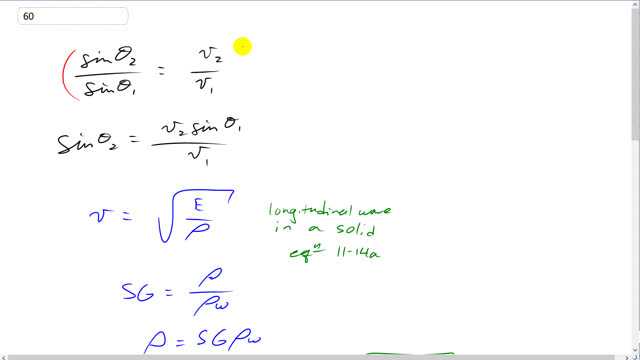
A longitudinal earthquake wave strikes a boundary between two types of rock at a angle. As the wave crosses the boundary, the specific gravity changes from 3.6 to 2.5. Assuming that the elastic modulus is the same for both types of rock, determine the angle of refraction.

In order to watch this solution you need to have a subscription.
This is Giancoli Answers with Mr. Dychko. Sign of the angle in the second medium divided by sine of the angle in the first medium equals the wave speed in the second medium divided by the speed in the first. And we can multiply both sides by sine θ1 and get the sine θ2 is v2 sine θ1 over v1. And the speed is something we have to deal with here because, you know, we have to use the elastic modulus and the density of the earth material to figure out the speed. And we know that we have a longitudinal wave here and formula for that wave speed in a solid is the square root of the elastic modulus of the material divided by its density. And we're not really given the density but instead were given the specific gravity. So, we know as pacific gravity is density divided by density of water. And we can multiply both sides by ρw and solve for density, ρ is specific gravity times density of water. So that means the speed in the second medium will be the square root of elastic modulus divided by specific gravity 2 times density of water. And I did not put a subscript on the elastic modulus because we're told that it's the same for both media so there's no need for a 2 or a 1 there. And then the speed in medium 1 is square root E over specific gravity 1 times density of water. So, when we divide these speeds, v2 divided by v2 which is what we're doing here, we have square root E over SG2 ρw. And then I'm going to multiply by the reciprocal of v1. So, that's going to be square root SG1 ρw over E. And the E's cancel and so do the densities of water and we're left with the specific gravity 1 divided by specific gravity 2, all square rooted is v2 over v1. So, we can write this in place of v2 over v1 in this formula. So, I have sine θ2 is square root specific gravity 1 over specific gravity 2 times sine θ1. So, θ2 then is the inverse sine of all that. And that makes it the inverse sine of square root 3.6 over 2.55 times sine 38. And that gives 48 degrees as the angle of refraction.